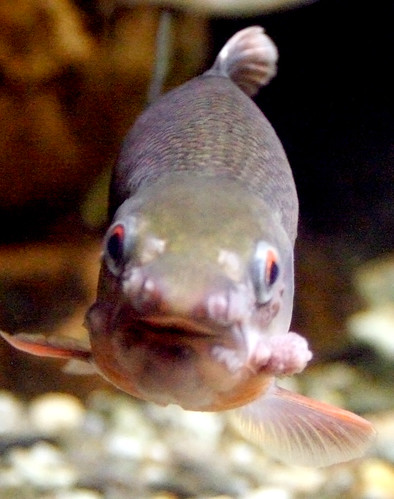
Researchers studying water and aquatic life
The culprit? Many would have you look no further than that little pack of pills on your bedside table. Synthetic estrogens in hormonal birth control trick the body out of ovulating, but they don’t just stay in the body and build up forever. A woman takes her pill with her morning coffee, drinks her eight glasses of water a day, and eventually those hormones get flushed town the toilet. When wastewater is spilled or leaks into waterways (through leaky sewers and pipes, storm drain overflow, or from wastewater treatment centers), those hormones are released into the wild, where they act as endocrine disruptors for fish. The endocrine system regulates growth and development in all animals – disrupt it, and you get animals that don’t develop correctly.
Scientists have found relatively low levels of estrogens in most of the bodies of water examined, but those low levels have been enough to have an impact on the development of aquatic life, and many are concerned for the reproductive future of fish. If you’re not worried (you never really liked fish anyway), think about the worst case scenario: feminization of male fish leads to widespread reproductive failure, declining fish supplies, the collapse of the fishing industry, increased reliance on non-aquatic protein supplies, and not enough land for the necessary increase in agriculture. It would be a problem in the
But we’re not there yet. Doomsday scenario aside, there is something going on with all those estrogens. Many news reports have implied that the bulk of the blame lies with hormonal birth control (and, to a lesser extent, hormone replacement therapy), meanwhile ignoring the vast number of estrogen-mimics in the environment from pollutants. Chemicals contained in many detergents, in bath oils and some cosmetics, and in pesticides act as endocrine disruptors in the same fashion as synthetic estrodiol. Even more pervasively, plastics often contain ingredients that mimic estrogens – one of which, bisphenol A, has been linked to birth defects in humans. These chemicals are often referred to as ‘ubiquitous’ by researchers who realize that the compounds will be found (in varying degrees) in essentially any water test performed.
Hormonal birth control, meanwhile, may be one of the most sustainable inventions ever created – if we use it properly. Because pills are relatively expensive and difficult to distribute (both problems which probably wouldn’t be that hard to overcome), their use in developing countries has yet to become widespread. Giving women and families the option of hormonal birth control (along with condoms and education) could go a long way towards solving the population problem. Otherwise, dwindling resources coupled with increasing populations will likely lead to population control via genocide and war (as in
It’s true that synthetic hormones in birth control are contributing to the feminization of fish. As a first world country, we should take the lead in developing birth control methods that are even more sustainable – both personally and globally. For the time being, women who would prefer birth control sans hormones can consider using a diaphragm or IUD.
Meanwhile, cutting back drastically on our nasty plastic habit would decrease the amount of trash in our landfills, the level of endocrine disruptors in our water, and our over-dependence on petrochemicals. That’s three problems in one fell swoop.
Researchers are working on ways to filter endocrine blockers out of wastewater, and no one is actually suggesting that women should stop using hormonal birth control. Still, the Pill is getting an undue amount of attention in the fish feminization scandal. We (the media, all of it) should put a little more emphasis on the plastics industry and the byproduct of our petrochemical dependence.
(fabulous fish photo by wistine)
2 comments:
nice report! I learn.:)
Thanks, Wistine -- and thanks for letting me borrow the photo! You're a great photographer.
Post a Comment